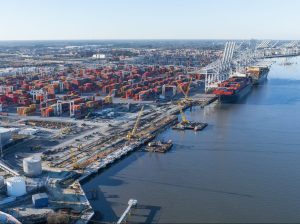Harnessing the Power of Port Markets: Black Salmon’s Optimistic Stance on Industrial
Though economic growth is slowing, Managing Director Stephen Evans is confident that certain markets will continue to see strong activity.
Although there is a growing sense of unease about the health of the commercial real estate industry—mainly due to banking woes— the industrial sector remains resilient. As of April, national in-place rents stood at $7.18 per square foot, up 7.3 percent year-over-year, according to CommercialEdge.
Contributing to the sector’s appeal are the port markets, which continue to show low vacancy rates and robust rent growth. The Inland Empire continues to lead the country for rent growth, accounting for an 18.2 percent increase year-over-year through April, while vacancy in the metro was as low as 1.9 percent. Los Angeles fared similarly, with rents growing by 12.3 percent and vacancy clocking in at 2.0 percent.
With such metrics, it is easy to understand why Black Salmon‘s Managing Director Stephen Evans remains bullish on port markets. A year ago, the company closed a $500 million industrial fund for the acquisition of land and construction of new product across the country. Commercial Property Executive asked Evans to expand on what’s defining today’s industrial market and why he remains steadfast on the growth of the sector despite a potential recession looming on the horizon.
READ ALSO: Barkham Predicts Mild Recession, Rapid Recovery
Tell us more about the types of industrial buildings you’re targeting with the fund you launched a year ago.
Evans: Black Salmon identified industrial investment as our key growth property sector and designed a strategy to capitalize on the disruption caused by the growth of e-commerce and the need for modern space from users. Our fund focuses on distribution warehouses, whether bulk distribution or last-mile facilities adjacent to population centers, port markets or major distribution centers.
We also invest in industrial properties that support the supply chain such as truck terminals, service facilities, and outdoor storage used for trucks, trailers and containers. Lastly, we believe cold storage has unique long-term value as e-commerce and automation have created more demand for newer facilities.
One of the investments the fund has already made is a 50-acre development site less than five miles from Port of Savannah, Ga. What made you choose this particular port market?
Evans: With the Port of Savannah being the fourth busiest port in the nation, we recognized the great opportunity to invest in Savannah, Ga., one of the strongest industrial real estate port markets in the U.S. According to the Georgia Port Authority, the Port of Savannah had a record container volume of 5.9 million 20-foot equivalent units in 2022, a five percent increase over the previous year. Moreover, the State of Georgia has made a massive investment in the port’s infrastructure to increase its capacity and fuel future growth. Griff Lynch, executive director of the Georgia Ports Authority, stated that the port has plans to invest $3 billion in the ports.
East Coast ports have materially increased container volume over the past several years, and that growth is anticipated to continue. This increased growth on the East Coast stems from the highly publicized delays experienced at West Coast ports, specifically Los Angeles and Long Beach. Shippers determined that they needed alternative and/or additional ports of entry to mitigate cost and timing issues in the supply chain. It is also important to note that the Port of Savannah has several strategic advantages, including the proximity to population centers, highway and rail access, and the Georgia Ports Authority’s commitment to the port’s growth and success.
We acquired the Savannah site parcels ideally situated for a truck terminal and transload facility with our development partner InLight Real Estate. We felt confident closing on the land prior to securing the tenant due to the market’s strong dynamics and the port’s desire and need to have such facilities on the ground to service increased container volume. We were delighted that a full building user was secured, and the project ultimately became a build-to-suit for a global logistics company on a long-term lease basis.
What are the main reasons you continue to bet on port markets?
Evans: We remain bullish on port markets due to their great fundamentals on either U.S. coast. On the West Coast, we like the ports of Los Angeles and Long Beach—collectively the busiest ports in the U.S.—due to the demand generated by the tremendous container volume.
Despite the recent reports of lower West Coast container volume, the region has a high population base estimated at over 12.5 million people, making the surrounding industrial market—Inland Empire—one of the most desired industrial markets by both users and investors coupled with robust container traffic.
On the East Coast, container volume has steadily increased as shippers look for additional ports of entry and alternative routes to reduce delays. As a result, East Coast markets—particularly Virginia (21 percent), Savannah (26 percent) and Charleston (28 percent)—have seen significant increases since 2019, according to FreightWaves.com. Therefore, we believe that the ports on the East Coast will continue to thrive, as well as their industrial markets, which capture the resulting demand.
In your view, what are the characteristics defining today’s industrial development market?
Evans: The clear height of industrial buildings has continued to increase over my real estate career. As users need more volume to rack higher or automate, the typical warehouse is built from 32- to 36-foot clear and, in some cases, to 40-foot clear. The clear height can be significantly higher in cold storage space depending on building codes. The reason for the higher clear height is to create efficiency and enable the use of automation—today or in the future.
Moving forward, it is highly likely that automation will become a more significant consideration when designing and constructing warehouses, primarily due to an aging workforce and the need to lower costs. This may include vehicles, parcel vans and truck charging stations, additional power, and air-conditioned spaces. Another desirable characteristic of modern warehouse sites is the ability to provide additional parking for trucks, trailers, containers and vehicles. Outdoor storage/parking has become scarcer as industrial-zoned land has been identified for future development—thus, users recognize the value of having sufficient land onsite.
What type of facilities are most in demand today and why?
Evans: Industrial tenants are all looking for the most efficient and cost-effective solution for their operations. Often, that means that tenants desire newly built, modern-designed buildings. According to CBRE, the average age of warehouses in the U.S. ranges from 18 years for the largest segment (more than 1 million square feet) to 45 years for the smallest segment (less than 50,000 square feet). The type of building that is desired greatly depends on the industrial use and specific needs of that user—whether for distribution, general purposes, cold storage, truck terminals, manufacturing/assembly and others.
READ ALSO: How Debt Costs Will Affect Industrial Demand This Year
You have a vast experience working with foreign institutional real estate investors. What is their view on the U.S. industrial sector, considering the capital markets volatility and the instability in the banking system?
Evans: Foreign investors are keenly aware of the industrial sector and how e-commerce has disrupted the overall real estate industry. Industrial was previously overlooked and was not the ‘sexy’ asset class due to its use. However, e-commerce changed that perception. The growing need of U.S. consumers for home delivery, whether soft goods, electronics, or food, has created an investment opportunity caused by e-commerce and its acceleration during the coronavirus pandemic.
Is the industrial sector headed for a slowdown? Why or why not?
Evans: All indications point to a slowing economy and continued challenges in the capital markets. Despite that, we remain confident that leasing activity will continue to be strong within the markets we focus on—port markets, primary and secondary distribution markets, and locations near population centers.
We do anticipate that the double-digit increases in rental growth that occurred over the past few years are unsustainable. That said, we are confident that strong and healthy rental growth will continue for the foreseeable future, and the long-term outlook for the industrial sector is very bright.
On the demand side, we believe that many new planned projects will fail to launch due to the negative effect that higher land prices, construction and/or excavation costs have on the profitability of these developments and the difficulty in sourcing construction financing. This should temper the amount of new supply in many markets. We also believe that we will see greater opportunity in sourcing acquisitions of high-quality industrial buildings where the weighted average lease term is short and the opportunity to capture the upside value in renewing leases is at current market rates.
Is there anything else you would like to add about what industrial real estate investors and developers should expect going forward?
Evans: An investor can be selective in this market today and will be rewarded for making prudent investment decisions. Given the current economic environment, the location of the investment is crucial today. As sizable new supply is coming online in certain markets, it is important to know what type of building is being built, what the size of the buildings are, and what are tenants in that market seeking. Ultimately, success is a result of recognizing and adhering to the driving forces of each market in which you invest.









You must be logged in to post a comment.